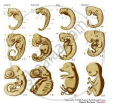Advertisements
Advertisements
प्रश्न
Observe the picture and answer the following questions.
A) Which evidence of evolution is shown in the picture?
B) What can be proven with this proof?
C) Give one more example of evidence of evolution
उत्तर
A) Embryological evidence of evolution has been shown in the picture.
B) Similarities between all embryos in early stages indicates that all those animals may have common ancestor.
C) Vestigial organs, Connecting link, etc.
APPEARS IN
संबंधित प्रश्न
Give two examples of vestigial organs in human beings and plants.
Differentiate between homology and analogy. Give one example of each.
(a) Select the homologous structures from the combinations given below:
(i) Forelimbs of whales and bats
(ii) Tuber of potato and sweet potato
(iii) Eyes of octopus and mammals
(iv) Thorns of Bougainvillea and tendrils of Cucurbita
(b) State the kind of evolution they represent.
Explain with an example for the given, how the following provides evidence in favor of evolution in organisms :
Homologous organs
“Two areas of study namely 'evolution' and 'classification' are interlinked'. Justify this statement.
Differentiate between analogy and homology giving one example each of plant and animal respectively.
How analogy and homology considered as an evidence in support of evolution ?
Four students A, B, C and D reported the following set of organs to be homologous. Who is correct ?
(A) Wings of a bat and a butterfly
(B) Wings of a pigeon and a bat
(C) Wings of a pigeon and a butterfly
(D) Forelimbs of cow, a duck and a lizard
Which one of the following pairs of vegetables is an example of homologous structures?
(A) Potato and sweet potato
(B) Carrot and radish
(C) Carrot and tomato
(D) Tomato and radish
Explain the terms analogous and homologous organs with examples.
What are homologous organs?
How do homologous organs help in providing evidence for organic evolution?
Select and write analogous structures from the list given below :
1) Wings of butterfly and birds
2) Vertebrate hearts
3) Tendrils of Bougainvillea and Cucurbita
4) Tubers of sweet potato and potato
In a class, students were asked to observe the models/slides/pictures of the skeletons of forelimbs and wings of different organisms. After the observations the students made the following groups of homologous structures. Select the correct group :
(A) Wings of a bird and a butterfly
(B) Wings of a pigeon and a bat
(C) Wings of a butterfly and a bat
(D) Forelimbs of a cow, a duck and a lizard
What do we call the degenerated or partially developed useless organs in living organisms? Enlist such organs in human body? How the same organs are useful in other animals?
Explain any three molecular (genetic) evidences in favour of organic evolution.
Define fossil.
Similarities in the initial stages indicate the _______ evidence.
Find an odd one out.
Give scientific reason.
Peripatus is said to be the connecting link between Annelida and Arthropoda.
Complete the flowchart.

The fossil remains of Archaeopteryx is a connecting link between ______
- Define vestigial organs.
- Write names of any two vestigial organs in the human body.
- Write name of those animals in which these vestigial organs are functional.
Evolution has exhibited a greater stability of molecular structure when compared with morphological structures. Comment on the statement and justify your opinion.
Evolutionary convergence is the development of:
The presence of gill slits, in the embryos of all vertebrates, supports the theory of ______.
Which is not a vestigial organ in a man?
Organs having similar functions but different origin and development are known as:
Appearance of antibiotic-resistant bacteria is an example of ______.
Did aquatic life forms get fossilised? If, yes where do we come across such fossils?
How do we compute the age of a living tree?
How do we compute the age of a rock?
Complete the following chart:

I am the connecting link of annelida and arthropoda. What is my name?
What is the function of the appendix of our digestive system?
Find the odd one out:
Define the term:
Homologous organs
Pick the odd man out:
